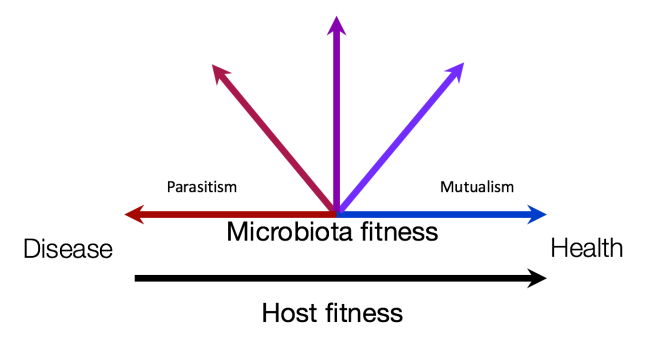Disease is a ubiquitous feature of life on earth. All biological life on the plant evolved. Diseases evolved too. Problem is, diseases are fitness reducing for their hosts. By that definition, diseases are maladaptive. Yet the motor of evolution, natural selection, favors traits that are adaptive, not maladaptive. Why then, does disease happen?
We will attempt to answer this question through the lens of conflict and cooperation during the 2022 University of New Mexico Evolutionary Medicine elective.
The question could be, why does selection sometime produce cooperation, and why sometimes conflict?
Shared fate tends to lead to cooperation, as discussed in the last entry. Mitochondria, thought to have evolved from free living organisms 2 billion years ago, now survive or perish along with their hosts. This incentivizes their cooperation with the larger host genome.
Same goes for the rest of our genes. These genes, of course, cannot replicate independently, and are tied to the overall life history strategy of the organism they are in. This promotes cooperative efforts, but this cooperation is not ironclad. Breakdown of this cooperative arrangement is what causes cancer.
What if a gene could come and go? That could cause a misalignment of fitness interests. Viral genes are free agents. At best they are expected to be a bad influence on cooperative genomes. As viruses successfully replicate in hosts they increase genetic conflict in the holobiont – the mammal-microbial collective of which human genes are but a minor part.

The more readily viral genes are able to hijack their hosts and find new hosts to exploit, the more meta-genomic conflict we should expect in a population. Successful genetic conflict is self-reinforcing. Short inter-infection intervals tend to favor virulent strains of the virus. When viral genes more intensely exploit their host and are rewarded with higher fitness, we have more conflict, and more severe disease. This partly explains why the first phases of the COVID-19 pandemic were ferocious, before public health measures became widespread.
Viral pandemics are a vivid reminder that free-agent genes can be dangerous. Another example of free-agent genes are those that cause communicable cancers, best exemplified in Tasmanian devil facial tumors and in clam leukemia. In a related example, some bacteria and viruses are able to provoke cancer in some cases. Destabilizing cooperation in the host genome can be a virulence feature of certain human papilloma viruses, and other cancer causing viruses. Recognizing this source of genetic conflict also offers opportunities, e.g. by preventing or eliminating those cancer-related viral genes with vaccines.
Another source of conflict is meiotic gene drive. Not all of an organisms genes make it into a gamete during meiosis, of course. In the classic Mendelian model, we each have two copies of a gene. Each gene (allele) should have an equal chance of making its way into a gamete. But this is not always the case. Genes are sometimes able to increase their representation in a gamete by a process called gene drive. Some meiotic drivers increase their own transmission chances by killing gametes that do not inherit them. This selfish behavior at the gene level can reduce the fitness of organisms carrying them. Researchers take advantage this effect when they alter mosquitos using CRISPR, adding genetically engineered lethal gene drive elements.This may help control outbreaks of dengue fever and malaria, among other diseases.
CRISPR gene drive and vaccines against cancer-causing viruses are promising examples of leveraging concepts of evolutionary medicine to benefit public health. These reduce genetic conflict in the human genome, or they exacerbate it in our evolutionary antagonists.
In later sessions we will explore the role of microbe-host genetic conflict in other non-communicable diseases, heart attacks, strokes, and metabolic diseases. We will also explore maternal fetal conflict, and the curious relationship between pregnancy, cancer and diseases linked to the microbiome.
Categories: Uncategorized
Joe Alcock
Emergency Physician, Educator, Researcher, interested in the microbiome, evolution, and medicine
Leave a comment